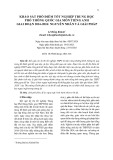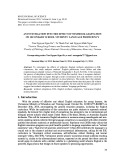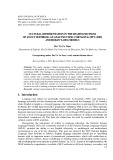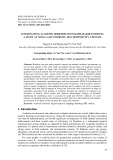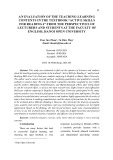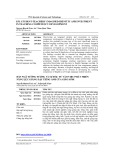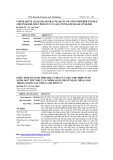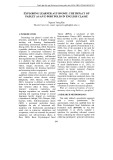
Tuyển tập Hội nghị Khoa học thường niên năm 2024. ISBN: 978-604-82-8175-5
559
TEST ANXIETY AMONG ENGLISH-MAJOR STUDENTS
AT THUYLOI UNIVERSITY
Nguyen Van Son
Thuyloi University, email: nvson@tlu.edu.vn
1. INTRODUCTION & RESEARCH
BACKGROUND
Test anxiety (TA) is a frequently
researched topic among educators, as TA
itself is also an issue that students regularly
face in their educational experiences. It is
defined as “the set of phenomenological,
physiological and behavioral responses that
accompany concern about possible negative
consequences or failure of an exam or a
similar evaluative situation” (Sieber, O’Neil,
& Tobias, 1977, p. 23). TA is a two-
dimensional construct including worry and
emotionality (Liebert & Morris, 1967). The
former refers to cognitive concern about the
likelihood of failure and its consequences,
whereas the latter is the physiological
adaptation entailed in states such as
nervousness and tension. These two
dimensions play important roles in designing
the inventories to investigate test anxiety
and are also employed in this study. The
literature (e.g., Balogun, Balogun, &
Onyencho, 2017; Cassady & Johnson, 2002;
Rana & Mahmood, 2010) indicates that TA
and student performance have a strong
relationship. Accordingly, there is a negative
relationship between TA and student
achievement. Academic under-achievement
has been more prevalent among high-test
anxiety students. Therefore, understanding
test anxiety from students’ perspective
would contribute to reducing negative TA
and enhancing positive performance. This
study aims to investigate TA among
English-major students at Thuyloi University
on the basis of worry, emotionality,
interference, and lack of confidence.
2. RESEARCH METHODS
Quantitative research was carried out and
survey questionnaires served as the data
collection method. Accordingly, this research
adapted the PAF Test Anxiety questionnaire
developed by Hodapp et al. (2011) including
four subscales which are worry (5 items),
lack of confidence (5 items), emotionality (5
items), and interference (5 items).
Participants needed to choose one option
from 1- Hardly ever to 4- almost always on a
Likert scale (see the items in Table 1).
111 second-year English-major students at
Thuyloi University took part in the study.
20.7% (n = 23) were male and 88 of them
(about 79.3%) were female. At the time of
research, they were going to have final exams
for many subjects.
The students completed the online Google
form questionnaire on a voluntary basis.
After one week of data collection, 111
questionnaires were completed for data
analysis. Data were analyzed after being
coded and entered into SPSS version 24, to
provide descriptive statistics for research
findings. An analysis of reliability indicated
that the value of Cronbach’s alpha was 0.947,
which was excellent, so the questionnaire
was reliable to be employed in this research.
3. RESEARCH FINDINGS
The descriptive statistics can be found in
Table 1.

Tuyển tập Hội nghị Khoa học thường niên năm 2024. ISBN: 978-604-82-8175-5
560
3.1. Worry
The results from the survey (items 1 to 5)
indicated a high level of worry about
examination among the participants (M =
3.45; Sd = 0.89). They highlighted the
importance of examination in their studies,
worried about the result, and thought about
the consequences of not doing well in the
exams. The percentages of usually and
almost always were really high among all the
items, whereas not many students chose
hardly ever and rarely.
3.2. Emotionality
The findings from items 6 to 10 showed
different states of emotions which are highly
related to test anxiety (M = 3.41; Sd = 0.37).
Specifically, the students’ heart pounded (M
= 3.25; Sd = 0.85), they felt anxious (M =
3.5; Sd = 0.82), upset (M = 3.32; Sd = 0.89),
and overwhelmed (M = 3.54; Sd = 0.68), or
shook with fright (M = 3.44; Sd = 0.76).
3.3. Interference
The data from items 11 to 15 revealed that
when doing the tests, the respondents were
interfered by anxiety-related thoughts (M =
3.45; Sd = 0.85) including distracting
thoughts (M = 3.44; Sd = 0.93), personal
problems (M = 3.52; Sd = 0.74), and
interfering thoughts (M = 3.29; Sd = 1.03),
and frequently got distracted and forgot what
they were thinking (M = 3.6; Sd = 0.71).
3.4. Lack of confidence
Items from 16 to 20 were in reverse order
in the way that they all mentioned
confidence, in stead of lack of confidence.
Accordingly, when asked whether the
students had confidence in their abilities or
performances, the number of students who
chose usually or almost always was not high
(M = 2.52; Sd = 0.2). For example, more than
50% of the students surveyed were not
convinced that they would do well. The
percentages for the four options tended to be
the same.
Table 1. Descriptive statistics on PAF
Item
M Sd HE(%) R
(%)
U
(%)
AA
(%)
1. I think
about how
important the
examination
is for me.
3.39 1.02 9.9 9.9 11.7 68.5
2. I think
about how
important it is
for me to
receive a
good result.
3.55 0.86 5.4 8.1 12.6 73.9
3. I worry
about my
results.
3.38 0.95 8.1 9.0 19.8 63.1
4. I am
concerned
about my
grades.
3.45 0.87 5.4 9.0 20.7 64.9
5. I think
about what
will happen if
I don’t do
well.
3.46 0.77 3.6 6.3 30.6 59.5
6. My heart
pounds.
3.25 0.85 6.3 7.2 41.4 45.1
7. I feel
anxious.
3.50 0.82 4.5 7.2 21.6 66.7
8. I tremble
with fear.
3.44 0.76 3.6 5.4 34.2 56.8
9. I feel
somewhat
overwhelmed.
3.54 0.68 2.7 2.7 32.4 62.2
10. I feel
upset.
3.32 0.89 6.3 9.9 28.8 55.0
11. Distracting
thoughts keep
“popping”
into my head.
3.44 0.93 7.2 9.0 16.2 67.6
12. I am
preoccupied
by other
thoughts that
distract me.
3.40 0.95 7.2 10.8 17.1 64.9
13. I easily
lose my train
of thoughts.
3.60 0.71 2.7 4.5 23.4 69.4

Tuyển tập Hội nghị Khoa học thường niên năm 2024. ISBN: 978-604-82-8175-5
561
Item
M Sd HE(%) R
(%)
U
(%)
AA
(%)
14. I forget
things because
I am too
preoccupied
with my
personal
problems.
3.52 0.74 2.7 6.3 27.0 64.0
15. My
concentration
is interrupted
by interfering
thoughts.
3.29 1.03 9.9 12.6 16.2 61.3
16. I am
confident
about my
performance.
2.75 1.13 19.8 20.7 24.3 35.1
17. I have
faith in
my own
performance.
2.65 1.19 25.2 18.0 23.4 33.3
18. I am
satisfied
with myself.
2.25 1.05 30.6 27.9 27.0 14.4
19. I think
that I will
succeed.
2.53 1.03 18.0 33.3 26.1 22.5
20. I am
convinced that
I will do well.
2.42 1.07 25.2 26.1 29.7 18.9
M = mean; Sd = standard deviation; HE =
hardly ever; R = rarely; U = usually; AA =
almost always.
4. DISCUSSION & CONCLUSION
The research investigated 111 English-major
students’ perspectives on test anxiety at
Thuyloi University using the survey
questionnaire adapted from the established
research. The results revealed that the sample
of students in this study expressed considerable
worry about the examination and its
consequences. That TA manifested itself in
fear, overwhelming state, heart pounded, and
also in distracting thoughts. Besides, many
participants showed a lack of confidence in
their performances and competences to do well
and succeed. The findings above were aligned
with those in the previous studies (e.g., Aydin
et al., 2020; Joy, 2013) in which test anxiety
was prevalent among the research participants.
This can be explained by the fact that doing
badly in the exams may lead to loss of face
which should be avoided in a collectivistic
society (Hofstede & Hofstede, 2005). The
anxiety could lead to distracting thoughts and a
lack of confidence. The findings in this study
confirm the literature on TA’s prevalence and
incidence (e.g., Joy, 2013).
This research offers some implications.
First, lecturers and relevant educators may
consider different types of assessment and
testing such as grading instead of scoring,
projects, presentations, and reduction of a
number of summative tests so that TA can be
lessened in order not to cause psychological
problems (Rana &Mahmood, 2010). Second,
students should take part in test development
and be informed of the test procedures and
content in order that they can feel their
responsibility for seriousness in studying and
revising and be more prepared for
examinations (Falchikov, 2004).
There are two main limitations in this study.
First, only the survey questionnaire was used
to collect data, so more research instruments
such as observation and interviews should be
considered for future studies to gain more
insights into TA. Second, the number of
participants was limited, focusing merely on
the students majoring in English studies at
Thuyloi University, so generalization is nearly
impossible to the broader population.
5. REFERENCES
[1] Aydin, S., Akkaş, F. D., Türnük, T.,
Beydilli, A. B., & Saydam, İ. (2020). Test
anxiety among foreign language learners: A
qualitative study. Qualitative Report,
25(12), 4289-4309.
[2] Balogun, A., Balogun, S., & Onyencho, C.
(2017). Test anxiety and academic
performance among undergraduates: the
moderating role of achievement motivation.
The Spanish journal of psychology, 20, E14.
[3] Cassady, J., & Johnson, R. (2002).
Cognitive test anxiety and academic
performance. Contemporary educational
psychology, 27(2), 270-295.

